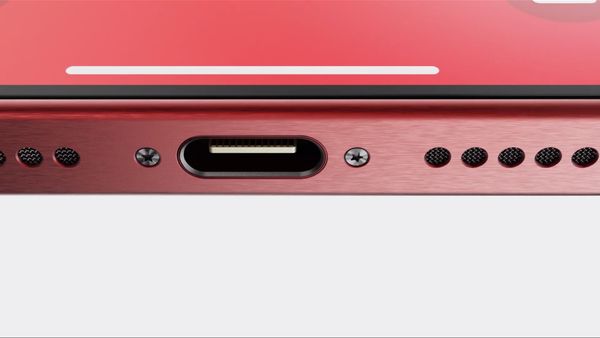
One of the biggest changes rumored to be coming to the iPhone 15 is the USB-C connector. After spending its 16 years of existence using some kind of proprietary charging cable, Apple is finally adopting the same standardized connector as everyone else — even if it may not entirely be Apple’s choice to do so.
This is a big deal. Partly because it means iPhones won’t be the odd one out where charging and accessories are concerned, but also because of how much more advanced USB-C has the potential to be compared to the Lightning cable. The problem is there’s a very real chance Apple will screw it all up by being, well, all Apple about it.
Or at least that’s what the rumors have been saying, and there’s no guarantee that the online speculation has any degree of truth. But. if I’m being honest it would actually be more surprising if Apple didn't do something to ruin USB-C’s potential on the iPhone.
iPhone 15 USB-C may be limited — unless you buy Pro
Lightning first debuted in 2012, back when USB was not as good as its more recent incarnations. It was a time when USB 2.0 reigned supreme, and Lightning has been stuck at that level ever since — complete with the 480 Mbps data transfer rate. Meanwhile USB has advanced through several different versions, resulting in the most recent USB 4 version 2 — which offers 80 Gbps data transfer speeds.
Currently, USB-C to USB-C cables are also capable of charging speeds up to 240W, though your actual charging speed will depend on whichever device you’re actively using. iPhones currently top out at 20W, provided you’re using a USB-C to Lightning charger and cable.
I’m bringing this up because there is a rumor claiming that the iPhone 15 and iPhone 15 Plus may be stuck at the same level as Lightning. Both phones are still rumored to be getting USB-C ports, but the actual port itself will be USB 2.0. The changes are effectively skin deep, and both phones will have the same speed-based limitations as the Lightning cable.
The iPhone 15 Pro and Pro Max will reportedly have no such limitations, and word is the two devices will support USB 3.2. It’s not the fastest or most recent version of USB, by any means, but it still offers 20 Gbps transfer speeds — more than 40 times faster than USB 2.0. This more advanced version of USB also opens up the potential to connect to more accessories that USB 2.0 isn’t fast enough to handle, including external displays .
The good news here is that USB-C’s maximum charging speed isn’t affected across different versions of the standard. “Hi-Speed USB” as USB 2.0 is now officially known can still handle charging speeds up to 240W if you have the right kind of cable.
So in a situation where the iPhone 15’s type-C port is limited to USB 2.0 speeds, the only charging restrictions you’ll face will come directly from Apple. This may be the result of the phone’s hardware, and how much power it can safely receive at any given time, or it could come from some specific software-induced shenanigans.
Made for iPhone could also make the transition
If you go out and buy a Lightning cable right now, you are left with two choices. Either buy one that has been certified by Apple, or buy one that hasn’t and deal with the fact your maximum charging speed will be cut in half. That’s all thanks to Apple’s “Made for iPhone” program (MFi), which certifies chargers and accessories to ensure they are fit for purpose. Meaning people can see the logo and understand that the product in question is both safe and sufficiently high quality.
Apple doesn’t do this out of the goodness of its heart; the company earns royalties on sales of Made for iPhone products. We don’t know how much Apple actually makes, but it does fall under the Wearable, Home and Accessories department that pulled in $41.1 billion last year — though this number does include money from the sale of products like the Apple Watch, AirPods, HomePod, and so on.
Up until now the MFi program has been limited to Apple’s in-house connectors — MagSafe, Lightning, and such. USB-C has been left alone, despite the growing number of Apple products that use the connector. But none of those products are the iPhone, which might as well be Apple’s personal money-printing machine — accounting for 52% of the company’s revenue in 2022.
So it’s no surprise that there have been rumors the Made for iPhone program may be making the jump to USB-C to coincide with its debut on the iPhone 15. That means using the USB-C cable and charger that came with, say, a Google Pixel, likely won’t be able to charge an iPhone 15 as fast as one made, or certified, by Apple.
The transition to USB-C was meant to facilitate better compatibility between devices. The idea is that your Android charging cable won’t be rendered completely usable because you upgraded to an iPhone — or vice versa. EU officials have even gone on record to say that any Made For iPhone-style restrictions would be illegal in the region.
Ensuring safety is one thing, but it’s not like we’re back in the early days of USB-C when stories of exploding chargers were all over the place. And it’s certainly rather suspicious that we never saw any sign of Made for iPhone going after USB-C until we started hearing believable reports that the port would be coming to its best selling product.
Bottom Line
In fairness to Apple, it’s not the only company to introduce proprietary restrictions on USB-C. Various companies have restricted the fastest charging speeds to their own homemade chargers, with third party alternatives being forced to use significantly slower speeds. But the number of companies that have done this has dwindled, especially as USB Power Delivery has gotten more common.
USB-C has a great many benefits over Apple’s Lightning cable, least of all the fact that the port doesn’t have to be stuck in 2012, the way Lighting does. But the rumors of these restrictions almost feels like Apple is throwing a tantrum at being told what to do. Much like asking a child to eat their broccoli, the desired results might not be what you’d initially hoped for.
The U in USB stands for Universal, but by potentially applying these restrictions, USB-C on the iPhone 15 may be anything but.










